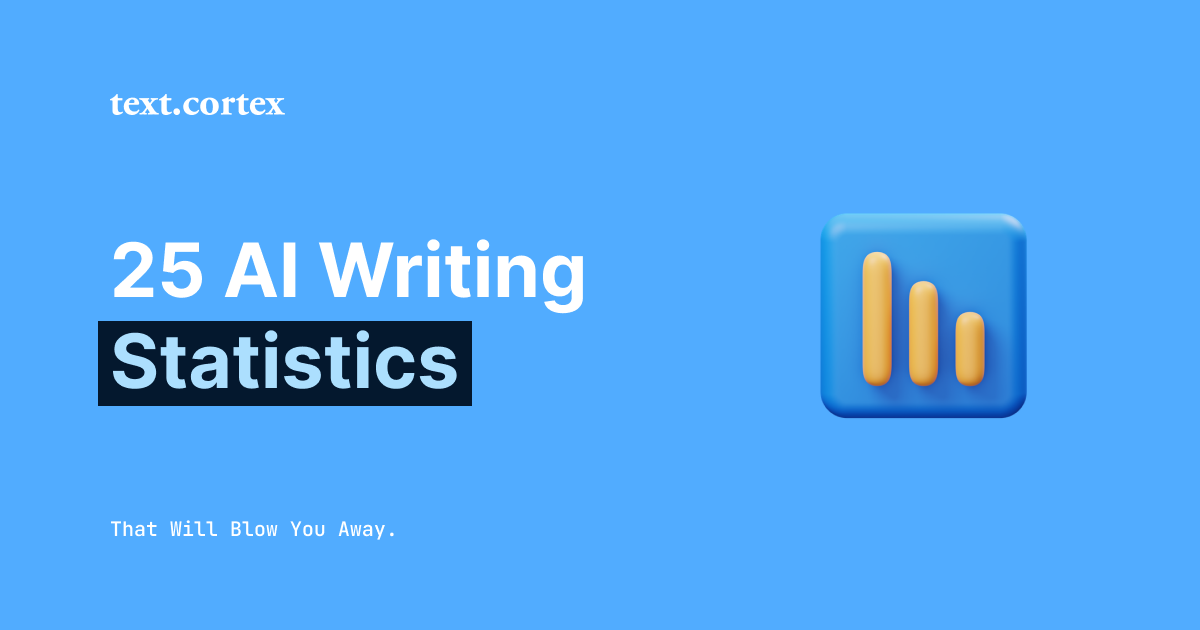Have you thought about incorporating AI writing into your content strategy but are unsure if it will be worth the effort?
With AI technology's rapid development, numerous worries are beginning to surface, including whether Google will penalize AI content and whether or not AI will replace copywriters in the future.
However, Alexa, Siri, and Cortana are already part of our everyday lives, right?
With all that AI surrounding us, it is only natural that the phenomenon called "AI writing" will happen eventually.

Furthermore, many professional content writers already use AI writing to boost content creation speed, and publishing effectiveness.
To assuage your concerns about incorporating AI writing into your content strategy, we will give you 25 solid AI writing statistics demonstrating their validity and usefulness in 2022.
Let's begin!
25 Best AI Writing Statistics That Will Persuade You to Use It
#1 Benefits Of AI In Everyday Life
According to Statista, here is what adults in the US consider to be the top 12 AI benefits in everyday life:
1. 72% think that AI can handle repetitive tasks
Did you know that 90% accuracy is expected for most jobs and interactions handled by AI bots in the banking sector?
2. 71% believe AI is smarter technology
Around 71% of people believe that AI is more innovative than people.
3. 71% find that AI improves technology efficiency
Did you know that 54% of businesses that employ AI say their productivity has increased? However, 80% of corporate executives think that AI can improve productivity.
4. 70% state that AI allows more widespread use of technology
Did you know that 57% of businesses using AI/ML by 2021 want to enhance customer experience?
5. 70% believe that AI reduces risk in dangerous jobs
In terms of workplace safety, utilizing the Internet of Things (IoT), AI can reduce threats tenfold and assist in the creation of a safer working environment.
6. 70% voted in favor of 24/7 availability
It goes without saying that once you have it, you can rely on AI technology to help you whenever you need it (24/7).
7. 66% claim that AI reduces human error
Artificial intelligence (AI) can successfully overcome human mistakes by performing the heavy lifting of parsing, analyzing, digging down, and dissecting enormous amounts of data.
8. 64% think that AI increases innovation
Did you know that by 2025, the agricultural robotics business will be worth $20.6 billion?
A total of $6.2 billion will be spent on drones or UAVs(Unmanned Aerial Vehicles).
9. 58% find that AI increased job creation in the technology field
According to the World Economic Forum's Future of Jobs Report, AI-powered machines will replace 85 million jobs by 2025.
While that statistic may make you nervous, the exact estimate claims that AI will produce 97 million new employment by 2025.
10. 58% believe that AI helps with more consistent decision making
By leveraging datasets with AI, enterprises and companies may make faster, more accurate, and consistent decisions.
11. 53% stated that AI provides better working conditions
In recruiting and compensating employees, AI will help eliminate unconscious and conscious prejudices, according to a report in the Economist.
Additionally, it highlights how using AI in the workplace will benefit workers in other ways, such as ensuring that the proper safety equipment is worn through sophisticated scanning technology.
12. 49% voted that AI increases economic prosperity
Did you know that AI can reduce call times by 70% in customer service industries resulting in a 40 to 60% cost saving?
#2 Global AI Writing Statistics In 2022
13. 40% of businesses say that streamlining the customer experience is the most important driver for adopting new technologies
AI is currently used the most for customer experience (40%), business analytics (33%), security (25%), and sales and marketing (16%).
14. 44% of Businesses Use AI technologies to lower operational costs
Most executives whose companies have used AI claim that it has increased revenue in the business sectors where it is utilized, and 44% report that it has decreased costs.
15. Implementing AI in a sales department can boost lead generation by more than 50%.
According to Harvard Business Review research, organizations who used AI in sales increased their leads by more than 50%, reduced call time by 60-70%, and realized cost savings of 40-60%.
16. 28% of companies use AI for marketing purposes
According to AI data, while artificial intelligence is becoming increasingly popular in numerous business areas, only 28% of top organizations employ it for marketing.
However, 84% of marketers believe that AI is more important than any other technology.
17. AI adoption in education is predicted to be worth $6 billion by 2024
According to Global Market Insights, global market growth will be further bolstered by increased investments and surpass the $6 billion level by 2024.
In addition, the application of AI in the Asia-Pacific area would result in excessive growth, with sales predicted to increase by 51% a year through 2024.
18. By 2027, 80% of retail companies anticipate using AI in some capacity
To enhance the client experience, 80% of retail CEOs want their businesses to utilize AI-enabled intelligent automation by 2027.
According to our current knowledge, 28% of American, 30% of Japanese, and 51% of European manufacturers have already included AI in their operations.
#3 Interesting AI Writing Statistics In 2022
19. Collaboration between educational and nonprofit organizations produced the most AI publications between 2010 and 2021
Collaboration between educational and nonprofit organizations produced the most AI publications between 2010 and 2021, followed by a collaboration between private companies and educational institutions and collaboration between educational and government institutions.
20. AI patent applications filed in 2021 is 30x higher than in 2015
With a compound annual growth rate of 76.9%, the number of AI patent applications filed in 2021 is 30 times higher than in 2015.
21. Humans perform 1% points better than AI on aNLI
Despite the fact that AI systems currently fall short of human performance on harder linguistic problems like abductive natural language inference (aNLI), the gap is steadily closing.
On the aNLI in 2019, humans performed 9% points better. By 2021, that difference had decreased to 1%.
22. AI systems improved by 129% on more general reinforcement learning tasks
AI systems have mastered restricted reinforcement learning tasks over the past ten years, where they are expected to maximize performance in a single skill, like chess.
Magnus Carlsen's peak ELO score is currently outperformed by the best chess computer program by 24%.
However, over the past two years, AI systems have also made 129% more progress on more general tasks that require them to operate in unfamiliar situations and are broader in nature.
This development points to the eventual creation of AI systems that can acquire a broader perspective.
23. AI training on classification systems has improved by 94,4%, while cost of training them has decreased by 63.3%
The cost of training an image classification system has decreased by 63.6% since 2018, while training times have increased by 94.4%, making AI more accessible and more effective.
Other MLPerf job categories, like a recommendation, object detection, and language processing, show a similar trend of lower training costs but quicker training times.
This tendency encourages the more broad commercial deployment of AI technology.
24. A 280 billion parameter model created in 2021 showed a 29% increase in induced toxicity
New research reveals that huge language models are breaking records on technical criteria and can also better reflect biases in the training data.
Over a 117 million parameter model thought to be state of the art as of 2018, a 280 billion parameter model created in 2021 shows a 29% increase in induced toxicity.
The systems are becoming progressively more powerful, but as their power grows, so does the potential severity of their biases.
25. The private investment in AI reached over $93.5 billion in 2021
While the number of newly funded AI startups continues to decline, from 1051 companies in 2019 to 762 companies in 2020 to 746 companies in 2021, the private investment in AI reached over $93.5 billion in 2021 — more than double the total private investment in 2020.
In addition, four funding rounds totaling $500 million or more in 2020 and fifteen in 2021.
To Sum Up
These statistical facts prove that content creation and management are essential tools for success.
And to take advantage of the mentioned opportunities, you need to build brand recognition, generate new ideas and share them with your targeted audience.
And what is a better way than having a writing assistant that will take over 80% of tedious writing work, help you produce 10x more content than manually, and improve your writing?
Precisely for that purpose, we created TextCortex — a use-case module-based AI writing assistant that will transform your thoughts into compelling content.
TextCortex is available as a web application and rewriter extension. It will help you:
- Create any content type you need (blog articles, social media posts, product descriptions, ads, emails, etc.)
- Incorporate both manual and AI-generated writing within an editable canvas.
- Allow you to format and edit your content on the spot.
- Create content in more than 72 languages.
- Rewrite your content for better context in bulk.
- Expand your text from a single sentence.
- Transform bullet points into an email.
- Create blog articles in any text box.
- Save projects for future use.
- And much more.
Our free version includes 15 free daily creations that you can increase at any time by validating or recommending the tool.
Additionally, there are no limitations on features, and registration doesn’t require credit card information.
Are you tempted to give it a try?
Sign up today and watch how TextCortex transforms any text into desirable content form within seconds while giving you the flexibility to work from the comfort of any text box.

